The NSW Equestrian Centre established in 1982 at Lochinvar in NSW’s Hunter Valley was probably the first real power-house stud in Australia, with massive advertising supported by the PR flair of the one-and-only Heath Ryan. By 1988, there were 120 horses on the property, 54 in work, a staff of ten with 14 live-in students.
In 1984, the Indoor School was opened, with 500 guests in evening dress, witnessing showjumping competition (won by Sky High), quadrilles, harness horses and a dressage display by international star, Jennie Loriston-Clarke.
The Oldenburg stallion, Ludendorf was imported in 1984, and thanks to Heath’s promotion, and the use of the relatively new technique of transported chilled semen, bred to an astonishing number of mares. Heath rode the horse at Advanced level One Day Events, and competed in a Dressage Grand Prix locally before he was retired at the age of nine with soundness problems.
The most successful of the Ludendorf progeny was the dressage horse, Londoner, who was a Prix St Georges star with Heath, and went Grand Prix with Mary Hanna, before he went unsound. The stallion son, Stirling Liberty competed at World Cup showjumping level but was not very tidy, and became better known for his party trick of jumping motor vehicles.
The next stallion to arrive at Lochinvar was a Dutch bred colt, Salute, a horse Rozzie found in England in 1989. He too was widely promoted and has had a number of competitive progeny. His best dressage son has been Stirling Stilton who was the highest scorer in the Australian Dressage Team at the WEG in Jerez in 2002, and Victory Salute who was short listed for hong Kong with Brett Parbery, and carried Georgia Bruce to a bronze in the Paralympics. Another son, Christopher has competed at Grand Prix level with both Heath and Rozzie.
An eventing son, Staccato competed at three star level with Craig Barrett, and at one stage rejoiced in the title of leading eventing stallion in the world on the WBFSH standings, and is now competing at FEI level dressage with Prue Barrett.
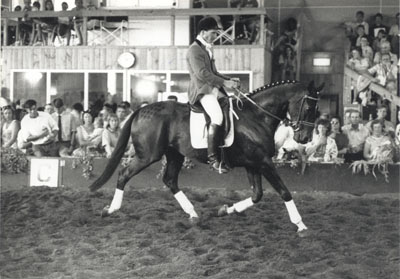
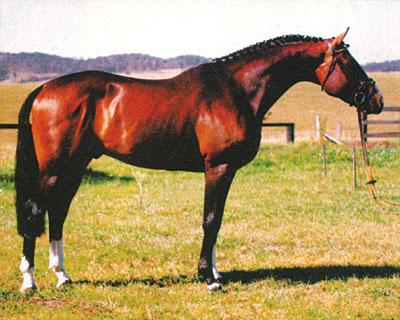
Strangely despite his showjumping pedigree, Salute has not bred any showjumpers of note.
Heath Ryan was a huge fan of the Danish stallion, May Sherif and tried desperately to import semen from that stallion to Australia. When that failed, he stood Richmeed Medallion, who was imported from England and by May Sherif out of one of Jennie Loriston-Clarke’s mares. The horse was too small to qualify as a stallion with the AWHA but attracted mares anyway. He recently died.
Dr Margaret Evans is a long standing supporter of Heath and more particularly, Rozzie, Ryan – she bought Rozzie her Australian Grand Prix Champion, Exellent. In Germany Margaret bred Regardez Moi, a colt foal by Rubinstein, who after growing up at Heath’s brother Matthew’s base in England, arrived in Australia as a 3 year old in 2000. The black stallion has had a sensational competition career. He was Australian Medium champion in 2004 and by 2007 was starring as a Grand Prix dressage horse. At the 2007 Sydney CDI, Regardez Moi was second in the Intermediaire II, 2nd in the Grand Prix and in his first ever Grand Prix Freestyle, he was a winner. At the 2007 Toowoomba CDI-W, he won both the Grand Prix and the Grand Prix Freestyle.
On one of her trips to Europe with Exellent, Rozzie purchased a colt by the Dutch stallion, Jazz, who as Jive Magic stands at Lochinvar. Jive Magic has been an accident prone horse, and a series of mishaps have set his career back but finally at the age of 11 he is starring – seemingly unbeatable on the small tour, he has now been named in the Australian talent squad.
Heath and Rozzie run two foal auctions a year and one performance horse auction. Their early performance horse auctions at the Centre, which began in 1984, broke entirely new grounds in terms of promotion and hype – and although focussed on performance horses of any breed, laid the way for later Warmblood production auctions – like the foal auctions they run today.
The Centre, and Heath and Rozzie Ryan, not only promoted their Warmbloods at top competitions around the country, but also set new standards in competition. It was at Lochinvar that Australia’s first international dressage event, the Lochinvar CDI was held in 1992, and although the CDI has moved to the far grander locale of our Olympic complex at Horsley Park, it all began at Lochinvar.
The Hanoverians
The Hanoverians were amongst the early arrivals. Domherr arrived in 1976, and sired, aside from Kibah Tic Toc, Dom Perignon, who Judy Dierks rode in the Australian Dressage team at the 1994 WEG in The Hague, as well as Dom Edin who competed at Grand Prix Dressage level with Heath Ryan.
The next Hanoverian was Duellschütz who arrived in 1979. He had the distinction of siring the first Australian bred Warmblood horse to represent Australia at an Olympic Games – EBA Schnapps – who was ridden by George Sanna at Seoul, and later sold to America. Duellschütz also sired Judy Mackay’s Grand Prix dressage competitor, Duell Diablo and Duell Silk, trained by the late Justice Ken Marks, and ridden at Grand Prix by Mary Hanna.
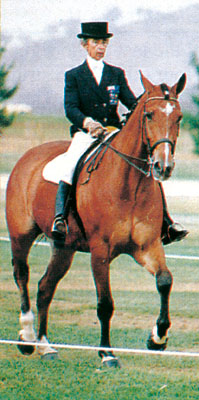
In 1983, Holger and Melanie Schmorl arrived from Germany to settle on 600 acres of the Darling Downs of Queensland. A third generation Hanoverian breeder, Holger brought with him two stallions, Daktylus and Winterkönig, and three mares: State Premium Mare Wolfsangel (Wolfsburg/Absatz); Gold Song (Goldstern – Gotthard/Lateran) and Gina (Goldstein – Gotthard – Goldfisch II/Pik Koenig – Abhang III – Goldfisch II – Gotthard).

The two stallions, Winterkönig (Woermann) and Daktylus (Diskus/Absatz), were later joined by the Thoroughbred, Silky Baby (USA) who was officially licensed by the Hanoverian Verband.
In 1992, Kinnordy imported Graf Landau (Genever / Gotthard) and then six years later, came Gymnastik Star (Glückspilz/Calypso II). The Rubinstein son, River Dance (out of an Atatürk mare) arrived in 2002. The Australian born Grand Ouverte (Graf Landau/Winterkönig) was licensed by the Hanoverian Commission in 1999, and has stood at stud since 2003. Danzante (De Niro/Weltmeyer) was imported in 2004.
The Kinnordy breeding program has so far produced two Australian international representatives – Wiking (by Winterkönig out of a Thoroughbred mare) who competed in the dressage team with Nancy French at the Rome WEG in 1998, and Genoa (by Graf Landau again out of an Australian Thoroughbred mare) who was in the showjumping team with Peter McMahon at Aachen WEG and Hong Kong.
In 1984, Theo Wagner, a Victorian businessman and a friend of the Schmorls, travelled to Germany to buy a Hanoverian stallion. He was determined to buy one from the State Stud at Celle, but unfortunately arrived in the middle of the European summer when all the stallions were out at the stallion stations serving mares… except one. No station would take Moselfischer, but Theo fell immediately in love with him. So little did the Hanoverian authorities think of the ‘M’ line that it happily exported its last representative to Australia – thus ending that line. Interestingly, 23 years later, Celle sold another stallion to Australia, Fisherman’s Friend, and in doing so closed the chapter on that particular ‘F’ line in Hanover.
The Trakehners
Trakehners have always been a force in Australian Warmblood breeding. Trakehner horses were first introduced to Australia in the 1970’s with the importation of the mare, Ariadne and later the stallion, Benito, by Dr Horner. Beefeater Alfa, out of Ariadne (imp) by Aquillo xx, was unbeaten in dressage and Reserve Champion Hack at Perth Royal, 1979 and 81. My Learned Friend (Benito) ridden by Liz Mills (now Owens) won the Dietmar Specht Memorial Trophy at the 1986 National Dressage Championships.
In Victoria, Fred Astaire arrived in 1978. In NSW, Ken Souter imported two licensed stallions, Kaliber and Korrit and the mare, Mira, in 1980.
In 1980, Walter Sauer imported four Trakehner stallions – Königsberg, Polarschnee, Copernicus and Zwion, and six Trakehner mares and one Holsteiner mare, to Australia. In 1983, two more stallions, Domhardt and Kassiber joined the band.
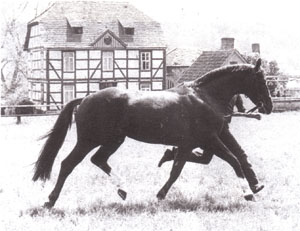
Sauer also got his horses out and competing in public. Königsberg, at the age of fourteen, was sent eventing. Partnered with John Patterson, Königsberg was second after the dressage at Gawler in 1982 on a score of 51.2 – Königsberg had a good run cross country but was withdrawn before the showjumping.
Kassiber was described as having been a member of the German Eventing team at the European Championships, although it might have been more strictly accurate to record that he competed as an individual, not a team member, in the European Junior Championships, but failed to present on the final day. Still in Australia he was flash enough to win the 1983 Australian One Day title at Echunga with Simon Kale. (It seems the tendency to exaggerate, works in both directions – when Rocadero was exported back to Germany by Sauer, he was described in German advertisements as ‘Australia’s top Grand Prix Dressage stallion’ – in truth he appeared in two Prix St Georges tests for scores of 49 and 51%.)
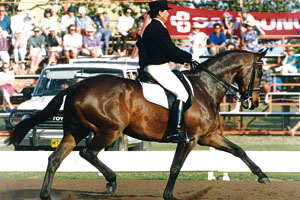
But it is true that Kassiber was one of the most successful sires to come to Australia. He produced a number of top class dressage horses: Kensington, Kudu, Solo, Spiegel, Socrates and Gumboot.
The grey stallion Polarschnee competed in a few showjumping classes, while the later arrival, Domhardt, competed up to FEI level before being sold to Indonesia.
In the West, Dr Horner of Beefeater Trakehners imported Elfenglanz in 1982, while Lyndon Woods and his wife, Sally Leigh (nee Horner) imported the black stallion, Lütz to their stud, Excelsior Trakehners, and later purchased the Sauer bred, Excelsior Fabian (Polarschnee / Feuerspiel).
Sally Leigh rode both stallions with success at FEI level. Elfenglanz was without doubt one of the most impressive dressage performers ever to compete in Australia, but had a head shake problem that prevented him ever making it to the top. Lütz competed with distinction at Grand Prix level.
In 1984, Polarschnee was sent to New Zealand, becoming the first Trakehner to stand in that country, producing the successful eventer, Jagermeister.
Domhardt spent a season in Tasmania with Ron Just, while Benito moved to John Tyrell’s Birdwood Trakehners in South Australia.
The German licensed stallion, Wesuw was imported in the early 80’s by the Cleary Brothers, and stood Supreme Warmblood at both the Sydney and Melbourne Royal Shows.
The stallion Falkensee was imported from New Zealand in 2002, and now stands in Tasmania.
Trakehner breeding associations in Australia have been fairly volatile…
The Trakehner Society of Australia was formed on October 25, 1985 with about 85 members at its peak, but two years later was facing opposition.
Australian New Zealand Trakehner Association was formed in February 1987 with the following manifesto:
“This group of twenty breeders, representing the interests of over eighty other breeders and friends, expressed dissatisfaction and frustration under previous arrangements and thus the ANZTA was formed.”
Then the New Zealand group broke away and it became the Australian Trakehner Association. The New Zealand group signed an agreement with the German Trakehner Verband in 1989 but in Australia, the Verband continued to be represented by the Trakehner Society until it was deregistered in 1996.
Trakehners Australia was formed in 2005, and as of 2007 is officially recognised by the German Trakehner Verband and has embarked on an exciting program of publicity for the breed and the breed society.
And if things get pretty hectic at times in the Trakehner ranks, action in the AWHA was hotting up too…
Next month – mayhem in the AWHA!


Gentlemen:
WALTER SAUER who is mentioned in “Australian Warmblood History Part 4 “was a class mate of mine in the late 1950s in Heppenheim,Germany. I would appreciate,if you could supply me with his address, Email or any hint of his whereabouts.
Sincerely yours,
E.Friedrich
WALTER SAUER,who is mentioned in” Australian Warmblood History Part 4″ was a classmate of mine in the late 1950s in Heppenheim,Germany. I would appreciate,if you could provide me with his address,Email or any hint of his whereabouts.
Thank you so much,
Sincerely yours,
Ernst Friedrich
I would love to say that Justice Ken Marks trained Duell Silk (later ridden by Mary Hannah), but he was bred by the late Ralph Crosby, came down from the stud at Flowerdale as a two year old and we broke him in. Art trained him for Ken, every day, Ken just riding him on weekends and holidays. He was with us for many years, Art teaching him changes, piaffe and passage. He only left us because we moved to N.S.W. and Ken wanted him to have a chance in competition and we recommended Mary to him. For those interested in breeding he was out of a pretty anglo arab mare, and he was without doubt, the best looking DuellSchutz bred!